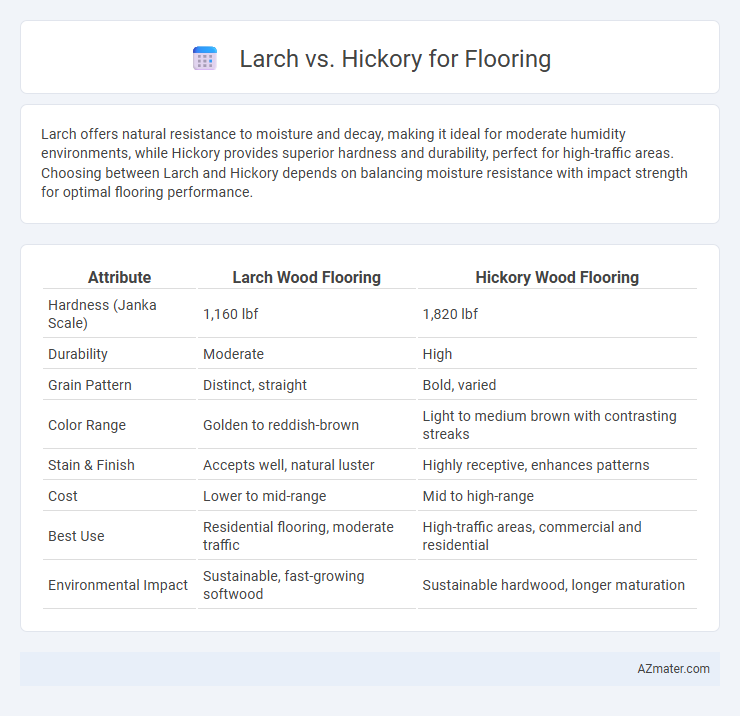Larch offers natural resistance to moisture and decay, making it ideal for moderate humidity environments, while Hickory provides superior hardness and durability, perfect for high-traffic areas. Choosing between Larch and Hickory depends on balancing moisture resistance with impact strength for optimal flooring performance.
Table of Comparison
| Attribute | Larch Wood Flooring | Hickory Wood Flooring |
|---|---|---|
| Hardness (Janka Scale) | 1,160 lbf | 1,820 lbf |
| Durability | Moderate | High |
| Grain Pattern | Distinct, straight | Bold, varied |
| Color Range | Golden to reddish-brown | Light to medium brown with contrasting streaks |
| Stain & Finish | Accepts well, natural luster | Highly receptive, enhances patterns |
| Cost | Lower to mid-range | Mid to high-range |
| Best Use | Residential flooring, moderate traffic | High-traffic areas, commercial and residential |
| Environmental Impact | Sustainable, fast-growing softwood | Sustainable hardwood, longer maturation |
Introduction: Larch vs Hickory Flooring
Larch flooring offers exceptional durability and a distinctive reddish hue, making it a popular choice for rustic and contemporary interiors. Hickory flooring stands out for its hardness, striking grain patterns, and natural color variations that enhance any room's character. Both Larch and Hickory provide robust, long-lasting options, with Larch leaning towards moisture resistance and Hickory excelling in impact resilience.
Hardwood vs Softwood: Key Differences
Larch, a softwood, offers moderate hardness and natural durability, making it suitable for flooring with a unique grain and resinous properties. Hickory, a hardwood, provides exceptional strength and scratch resistance, ideal for high-traffic areas requiring long-lasting durability. The key differences lie in Hickory's superior hardness rating of 1820 Janka compared to Larch's softer rating around 830 Janka, influencing wear resistance and maintenance needs.
Durability and Strength Comparison
Larch flooring offers moderate durability with natural resistance to decay, making it suitable for moderate foot traffic areas. Hickory flooring stands out for exceptional strength and hardness, ranking among the hardest domestic woods with a Janka hardness of 1,820, ideal for high-traffic and heavy-use spaces. Comparing both, hickory provides superior durability and impact resistance, ensuring better long-term performance in demanding environments.
Grain Patterns and Aesthetic Appeal
Larch flooring features distinctive, straight to slightly wavy grain patterns with a warm, reddish-brown hue that enhances rustic and natural interior designs. Hickory flooring boasts dramatic, contrasting grain with bold streaks and variations in color ranging from creamy white to rich brown, creating a dynamic and striking appearance. The aesthetic appeal of larch is subtle and consistent, while hickory provides a more vibrant and varied look ideal for statement flooring.
Color Variations and Finishing Options
Larch flooring offers warm tones ranging from pale amber to rich reddish hues, showcasing natural knots and grains that enhance rustic appeal. Hickory features a broader color spectrum with light creamy tans to deep browns, providing striking contrast and pronounced grain patterns ideal for dynamic interiors. Both woods accept stains and finishes well, with larch favoring matte or satin finishes to highlight its texture, while hickory's density allows for high-gloss options that emphasize its durability and color depth.
Installation Process and Considerations
Larch flooring requires precise moisture control during installation due to its natural resin content, which can affect adhesion and expansion. Hickory, known for its hardness and density, demands careful acclimatization and pre-installation conditioning to prevent warping and splitting. Both woods benefit from professional-grade fasteners and subfloor preparation to ensure longevity and stability under varying environmental conditions.
Maintenance and Longevity
Larch flooring offers moderate maintenance with natural resistance to moisture and decay, making it suitable for areas prone to humidity, while hickory requires more frequent upkeep due to its hardness and susceptibility to dents and scratches. Hickory boasts superior longevity and durability, often lasting decades with proper care, whereas larch provides a balance between durability and ease of maintenance but may show wear faster in high-traffic environments. Both woods benefit from regular sealing and refinishing to preserve their appearance and structural integrity over time.
Cost Differences: Larch vs Hickory
Larch flooring typically costs between $4 to $7 per square foot, making it a more affordable option compared to hickory, which ranges from $6 to $12 per square foot. The price difference is influenced by hickory's greater hardness and durability, which contribute to its higher market value. Homeowners seeking cost-effective flooring with decent resilience often prefer larch, while those prioritizing long-term wear and distinctive grain patterns choose hickory despite its premium price.
Eco-Friendliness and Sustainability
Larch wood offers high sustainability due to its rapid growth rate and widespread availability, making it an eco-friendly choice for flooring that reduces deforestation pressure. Hickory, while durable and dense, grows slower and requires more mature forests, impacting its environmental footprint negatively compared to larch. Choosing larch flooring supports sustainable forestry practices and carbon sequestration, aligning better with eco-conscious construction demands.
Choosing the Right Flooring for Your Needs
Larch flooring offers excellent durability and moisture resistance, making it ideal for high-traffic and humid areas, while Hickory flooring stands out with its superior hardness and striking grain patterns, perfect for those seeking a robust, visually dynamic surface. Choosing the right flooring depends on balancing Larch's resilience and natural warmth against Hickory's exceptional hardness and distinctive color variations to match your lifestyle and design preferences. Consider factors like foot traffic, humidity levels, and aesthetic goals to ensure the selected wood meets both functional requirements and enhances your interior decor.

Infographic: Larch vs Hickory for Flooring
 azmater.com
azmater.com